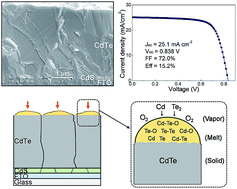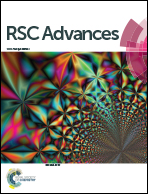High efficiency CdTe solar cells with a through-thickness polycrystalline CdTe thin film
Abstract
The absorber layer in a CdTe solar cell is made of a polycrystalline CdTe thin film with a thickness of several μm. It is highly desirable that the CdTe film could be made of through-thickness CdTe grains. In such a case, the photon-generated carriers could be transported to the positive and negative contacts without encountering any grain boundaries in CdTe, thus significantly reducing the carrier scattering/recombination occurring at the grain boundary. We propose and demonstrate that one of the most important roles for the presence of oxygen during the CdTe film growth is to in situ form a low-melting liquid mixture of oxides (CdTeOx, TeOx and CdOx), Te, and CdTe on the growth front of the CdTe grain surface. This liquid mixture, having a thickness of ∼50 nm, assists material transport from the vapor through the liquid to the liquid–solid interface, where Cd, Te, and Cd–Te molecules reacted to epitaxially deposit on the CdTe growth front. Assisted by a highly crystalline mono-grained CdS window layer template, CdTe preferential growth with through-thickness grains along the normal direction of the film has been achieved. CdTe solar cells fabricated with such CdTe absorbers demonstrate much enhanced external quantum efficiency, and cells with efficiencies as high as 14–15.2% have been fabricated.


 Please wait while we load your content...
Please wait while we load your content...